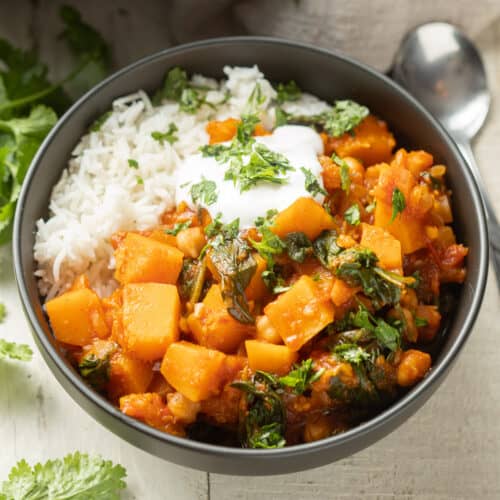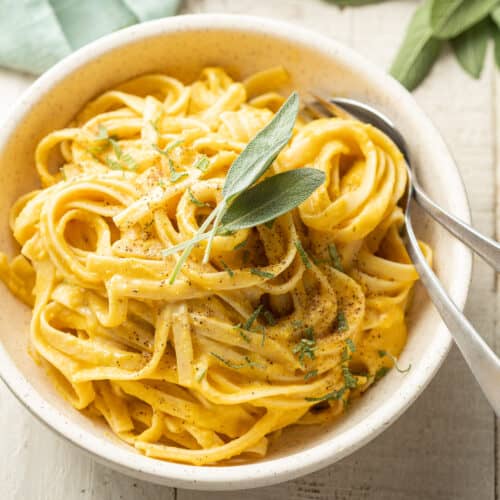
My kabocha squash soup is silky smooth, lightly sweet, and infused with the warm spices of Japanese curry. It’s the ultimate cozy fall soup, easy to make, naturally vegan and gluten-free, and absolutely irresistible!

I’ve never met a winter squash I didn’t love, but soups are probably my favorite way to enjoy them. My vegan pumpkin soup, vegan butternut squash soup, and acorn squash soup are all in heavy rotation during the colder months. This year though, I keep coming back to this kabocha squash soup. What sets this soup apart is how the natural sweetness of kabocha plays off the warming spices of Japanese curry.
[feast_advanced_jump_to]
Kabocha is one of the best squashes for soup. Its flesh cooks up silky smooth, similar to acorn squash, but denser. It’s also sweet like butternut, but with a richer, deeper flavor.
Since kabocha is a Japanese variety of squash, I season my soup with Japanese curry powder, just like I do in my vegan Japanese curry. The warming spices pair beautifully with the squash’s naturally sweet, nutty flavor. A big bowl of this with some crusty bread is my ultimate fall happy place.
Ingredients You’ll Need
Below you’ll find a list of ingredients in this recipe, with notes and substitutions. Scroll all the way to the bottom of the post to see the full recipe, including the amount of each ingredient.

- Kabocha squash. Lots of regular grocery stores carry this in the fall. If yours doesn’t, try a farmer’s market.
- Olive oil. Other high-heat oils like peanut or vegetable oil can also be used.
- Onion.
- Apple. The flavor of an apple goes great with both kabocha squash and Japanese curry spices. I like a sweeter variety, like Fuji or Honeycrisp with this recipe, but feel free to experiment.
- Garlic.
- Ginger.
- Japanese curry powder. Look for this blend in the spice aisle or international aisle of your grocery store. S&B is a pretty common brand to look for. If you can’t find it, a mix of mild curry powder and garam masala will give you a similar flavor profile.
- Vegetable broth.
- Coconut milk. The recipe calls for full-fat coconut milk, but light will work if you’d like to reduce the fat and calorie content of the recipe.
- Salt and pepper.
How It’s Made
The following is a detailed photo tutorial on how to make this dish. Scroll all the way down if you’d like to skip right to the recipe!
Step 1: Prepare. Preheat your oven to 400° and line a baking sheet or two with parchment paper.

Step 2: Prep the squash. Cut it into wedges. You should have around eight, but don’t fuss too much on this. Scrape out the seeds and pulp, then rub the wedges with olive oil and place them on your baking sheet.

Step 3: Roast the squash. Pop the baking sheet into the oven and roast your squash wedges until they’re tender. They should be easily pierced with a fork and browned in spots.
Tip: Roasting the squash is an extra step, but it’s well worth it! It caramelizes the squash, enhancing its flavor and sweetness. It also makes it much easier to chop and peel!

Step 4: Peel and chop. The skin should come off of your squash wedges really easily now. Take what’s left after removing it, and roughly chop it up.

Step 5: Cook the onion and apple. Sweat them in some olive oil for a few minutes, stirring occasionally, just until they start to soften.

Step 6: Add spices and aromatics. Stir in minced garlic, grated ginger, and Japanese curry powder. Cook everything briefly, stirring the whole time so nothing burns.

Step 7: Simmer the soup. Add your broth and roasted squash. Bring the broth to a boil, lower the heat, and let it simmer for a bit.

Step 8: Blend. I like using an immersion blender, but you can also transfer the soup to a conventional blender and blend it in batches. Make sure to get it super smooth!

Steps 9 & 10: Finish. Finish your soup with some coconut milk, and salt and pepper to taste. Warm it back up on the stove if you’d like.

Your kabocha squash soup is ready to enjoy. Ladle it into bowls, and sprinkle on any toppings you’d like, such as pepitas, chopped scallions, and a drizzle of coconut oil.
Variations
- Add veggies. Throw in some veggies that will add sweetness, like carrots, parsnips, or a small sweet potato.
- Make it extra spicy. Add some heat with cayenne pepper, sriracha sauce, or a sprinkle of chili crisp on top.
- Try different curries. I love this recipe with Japanese curry powder, but you could use basic mild curry powder, Indian curry powders like madras or garam masala, or even Thai curry pastes.
Frequently Asked Questions
Yes, it is!
Leftover kabocha squash soup will keep in an airtight container in the fridge for about three days, or in the freezer for about three months.
Nope! It enhances the flavor and texture, but you can certainly skip it if you’re pressed for time. You’ll need to increase the simmer time in step 7.
Some people like to enjoy kabocha with the skin on, but for this particular dish I recommend removing it.
More Winter Squash Recipes
Like this recipe? If so, please stop back and leave me a review and rating below if you try it! Also be sure to follow me on Facebook, Pinterest or Instagram, or subscribe to my newsletter for more recipes like this one!
📖 Recipe

Kabocha Squash Soup with Japanese Curry
#wprm-recipe-user-rating-0 .wprm-rating-star.wprm-rating-star-full svg * { fill: #343434; }#wprm-recipe-user-rating-0 .wprm-rating-star.wprm-rating-star-33 svg * { fill: url(#wprm-recipe-user-rating-0-33); }#wprm-recipe-user-rating-0 .wprm-rating-star.wprm-rating-star-50 svg * { fill: url(#wprm-recipe-user-rating-0-50); }#wprm-recipe-user-rating-0 .wprm-rating-star.wprm-rating-star-66 svg * { fill: url(#wprm-recipe-user-rating-0-66); }linearGradient#wprm-recipe-user-rating-0-33 stop { stop-color: #343434; }linearGradient#wprm-recipe-user-rating-0-50 stop { stop-color: #343434; }linearGradient#wprm-recipe-user-rating-0-66 stop { stop-color: #343434; }
Ingredients
- 4 pounds kabocha squash (about one large squash)
- 2 tablespoons olive oil, divided
- 1 medium onion, diced
- 1 medium apple (Fuji or Honeycrisp work well) peeled and diced
- 3 garlic cloves, minced
- 1 tablespoon freshly grated ginger
- 1 tablespoon Japanese curry powder, plus up to an additional tablespoon, to taste (Note 1)
- 3 cups vegetable broth
- 1 cup full-fat coconut milk
- Salt and pepper, to taste
Optional Accompaniments
- Additional coconut milk, for drizzling
- Toasted pepitas
- Chopped scallions
Instructions
-
Preheat the oven to 400°F and line a large baking sheet or a couple of small baking sheets with parchment paper.
-
Cut the squash into about eight wedges, then use a spoon to scrape out the seeds and inner pulp. Rub the squash wedges lightly with a tablespoon of olive oil.
-
Roast the squash for about 40 minutes, until the pieces are fork tender and lightly browned in spots. Let them cool for a few minutes.
-
Once the squash is cool enough to handle, remove the peel and roughly chop up the rest of it.
-
Coat the bottom of a large pot with the remaining tablespoon of oil and place it over medium heat. Give the oil a minute to heat up, then add the onion and apple. Cook the mixture for about 5 minutes, stirring frequently, until softened.
-
Stir in the garlic, ginger, and curry powder. Cook the mixture for about 1 minute, stirring constantly, until it becomes very fragrant.
-
Stir in the broth, then add the roasted squash to the pot. Raise the heat and bring the liquid to a boil, then lower the heat and let it simmer for about 15 minutes.
-
Remove the pot from heat. Blend the soup until it's completely smooth. You can use an immersion blender if you have one, or working in batches, carefully transfer the soup to a regular blender, blend the soup, then return it to the pot. Always use caution when blending hot liquids.
-
Stir in the coconut milk. Heat the soup back up if it has cooled down too much.
-
Season the soup with salt and pepper to taste. Ladle into bowls and serve.
Notes
- Use 1 tablespoon for milder flavor, or 2 tablespoons for more intense flavor. If you’re not sure how much to use, start with 1 tablespoon, then add more to taste at the end.
Nutrition
The post Kabocha Squash Soup With Japanese Curry appeared first on Connoisseurus Veg.





